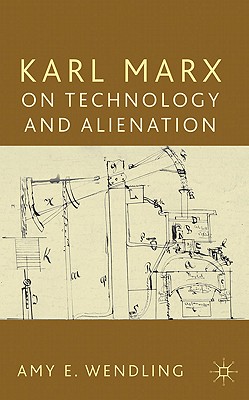Amy E. Wendling: Karl Marx on Technology and Alienation (2009)
Filed under book | Tags: · alienation, capitalism, communism, labour, machine, philosophy, philosophy of technology, revolution, technology, thermodynamics, value, women, work

“In Karl Marx on Technology and Alienation, Amy Wendling draws on lesser known archival materials, including Marx’s notebooks on women and patriarchy and technology to offer a new interpretation of Marx’s concept of alienation as it develops throughout his works. For Marx, technology exemplifies the interaction between human beings and nature. Marx’s description of this interaction is in transition throughout his works. An older, humanist and vitalist paradigm sets the human being against nature as a qualitatively different type of force. A newer, thermodynamic paradigm sets the human being and nature in continuity. Marx’s work occurs at the juncture of these paradigms and contains elements of each. This affects his deployment of the concept ‘labor’. Labor is demoted from its status as a meaningful human activity that confers political status and mastery of the natural world, and it becomes a mere nodal point where energy is transferred. Against this backdrop, Marx increasingly appealed not to meaningful labor but to the abolition of labor as the culmination of human freedom. He also shows how the labours of members of the working class, including women, are interpreted in the old and new paradigms.”
Publisher Palgrave Macmillan, 2009
ISBN 0230224407, 9780230224407
272 pages
Reviews: Chris Arthur (Marx & Philosophy Review of Books, 2010), Richard Cotter (LSE Review of Books, 2013), Tom Bunyard (Historical Materialism, 2014), McKenzie Wark (Public Seminar, 2015).
Comment (0)Siegfried Giedion: Mechanization Takes Command (1948)
Filed under book | Tags: · agriculture, architecture, furniture, history of technology, industry, machine, movement, philosophy, philosophy of technology, production, technology

“First published in 1948, Mechanization Takes Command is an examination of mechanization and its effects on everyday life. A monumental figure in the field of architectural history, Siegfried Giedion traces the evolution and resulting philosophical implications of such disparate innovations as the slaughterhouse, the Yale lock, the assembly line, tractors, ovens, and “comfort” as defined by advancements in furniture design. A groundbreaking text when originally published, Giedion’s pioneering work remains an important contribution to architecture, philosophy, and technology studies.”
Publisher Oxford University Press, New York, 1948
Third printing, 1970
743 pages
via babyalanturing
Reviews: John E. Sawyer (The Journal of Economic History, 1949), Harry Elmer Barnes (American Journal of Sociology, 1949), William F. Ogburn (The American Historical Review, 1948), Henry Guerlac (American Quarterly, 1949), Donald Horton (American Sociological Review, 1948), Paul Zucker (The Journal of Aesthetics and Art Criticism, 1949), Arthur P. Molella (Technology and Culture, 2002), Tom Vanderbilt (Bookforum, 2010), Bryan E. Norwood (Culture Machine, 2015).
PDF (removed on 2014-4-21 upon request of the University of Minnesota Press)
Comment (1)Eduardo Paolozzi: As Is When (1965)
Filed under artist publishing | Tags: · machine, pop art

As Is When is Eduardo Paolozzi’s homage to the philosopher Ludwig Wittgenstein created after reading his biography written by George Vaughan Wright. Wittgenstein’s study of linguistic systems coincided with Paolozzi’s love of toys and games and influenced his approach to the “syntax” and “vocabulary” of picture-making. The work began as a series of collages whose components were drawn from Paolozzi’s vast collection of found printed ephemera, which included such diverse materials as Woolworth wrapping paper and clippings from engineering manuals. Each of them was accompanied by quotations from Wittgenstein’s own writings or passages from the biography book.
Paolozzi has described the prints as “a kind of combined autobiography”. The screenprint process was realised by Chris Prater of Kelpra Studio. Paolozzi credits Prater with “reinterpreting a series of collages into a sound homogenous graphic [that was].. highly innovative, highly inventive, or, in some cases, another art form.” The images in As Is When are considered by many to be the first Pop masterworks of screenprint in England. In the U.S., Warhol had only released isolated editions by this point, and important portfolios such as 11 Pop Artists and Grafik des Kapitalistischen Realismus were yet to happen. (Source)
The titles of the prints are as follows (in the order in which appear in the PDF): Poster; Artificial Sun; Tortured Life; Experience; Reality; Wittgenstein the Soldier; Wittgenstein in New York; Parrot; Futurism at Lenabo; Assembling Reminders for a Particular Purpose; The Spirit of the Snake; He must, so to speak, throw away the ladder; Wittgenstein at the Cinema Admires Betty Grable.
Publisher Editions Alecto, London, 1965
Edition of 65
12+1 screenprints
via Tate

